Split peas is a favorite at home. It is also very simple to prepare. Generally, when we think of split peas we think of dhal, but sometimes split peas is cooked with a salted meat such as pig tail, smoked bone, or salt fish to give it a unique flavour. Dhal is one of our no-fuss meals that goes great with rice, or roti. Now that you know how to make a dhal gutney you can try it out when making this recipe and experience how we really make dhal in Trinidad and Tobago.
Most people shy away from eating split peas because it induces flatulence. It is so, split peas, like many other peas, such as lentil peas, black eye peas, red beans, pinto beans, etc. can produce gas in the body. Some more than others. Split peas and lentil peas are the least, but there are some people who find that that much is still a lot. The flatulence experience from eating such peas are not so tolerable when it is intense, for some it can lead to much distress, pain and headache
We advise that you always soak your peas. Soak it for at least 7 hours to 12 hours before you begin to cook it. During that time, you should remove the water, at least three times. Never use the water the peas soaked in in your cooking. Soaking the peas is important, as it makes the peas more digestible for the body.
On the whole beans are high in oligosaccharides, a starch the is not digested in the intestines, but are broken down in the colon by bacterial fermentation. This is what causes the gases. An extra step to reduce the gas in peas, is by soaking and fermenting the peas. Adding a bit of whey to the water could help tremendously. Again make sure you rinse the peas in running water before cooking. This method will do for all peas. Also, soaked peas cook a lot faster. So it is always good to soak the peas. However, I would still recommend pressure cooking the peas. Pressure cooking allow peas to also be easily digested. I would not recommend slow cooking peas.
Dhal Recipe
Now, you can use any type of split peas for this recipe. There are two varieties of split peas: green and yellow. The green is sweeter and less starchy than the yellow. The yellow is more popular. I especially enjoy split peas in soups. They both cook faster, and most people would say it would need no soaking. However, I would still say go ahead and soak the split peas.
DHAL
Ingredients:
1 cup split peas
1 small onion
1 pimento
4 leaves chadon beni
1/2 tsp. geera (cumin) powder
1/2 tsp. saffron (hardi) powder
4 cloves garlic
3 cups water
Oil for chongkaying
Salt to taste
Method:
Soak the split peas overnight. Chop the onion, pimento, and chadon beni. Pour the peas, onion, pimento, 2 cloves garlic, chadon beni and saffron powder in a pressure cooker with the water for about 15 minutes. Do not ever add salt at this stage of the cooking. You will find the peas staying somewhat hard.
When done, add salt and geera.
And swizzle well, preferably with a dhal gutney to a pureed consistency.
Chongkay the dhal by frying the other two cloves of garlic in a kalchul and when brown add to the dhal. Caution: this process makes a loud frying sound when the hot oil and garlic is added. To prevent burns, when the oil is added, cover the pot with the pot cover at once.
Hope you enjoyed; lots more recipes to come.
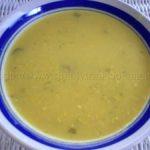
Dhal
Ingredients
Instructions
- Soak the split peas overnight. Chop the onion, pimento, and chadon beni.
- Pour the peas, onion, pimento, 2 cloves garlic, chadon beni and saffron powder in a pressure cooker with the water for about 15 minutes.
- When done, add salt and geera; swizzle well to a pureed consistency.
- Chongkay the dhal by frying the other two cloves of garlic in a kalchul and when brown add to the dhal. (Caution: this process makes a loud frying sound when the hot oil and garlic is added. To prevent burns, when the oil is added, cover the pot with the pot cover at once. ).
- Serve hot.




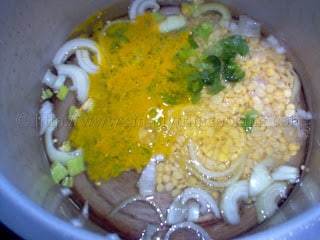
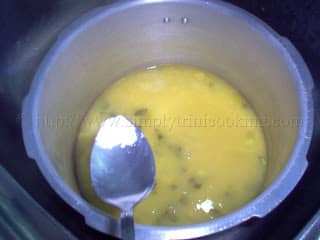
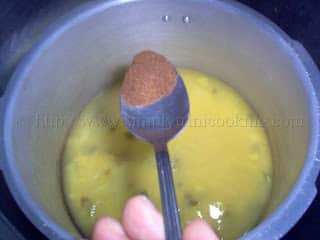
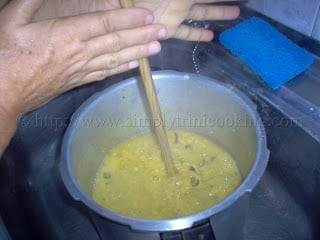
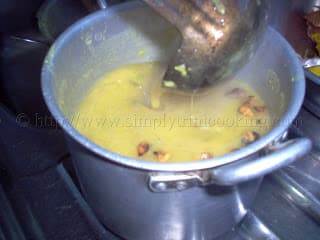
You probably do it now, I am not certain, but it would help quite some if you would say how many persons the recipe serves. That way viewers can know if to make more or less of it.
also to instruct on what to do if no pressure cooker
That’s easy just boil until the peas is cooked. Would take longer though!